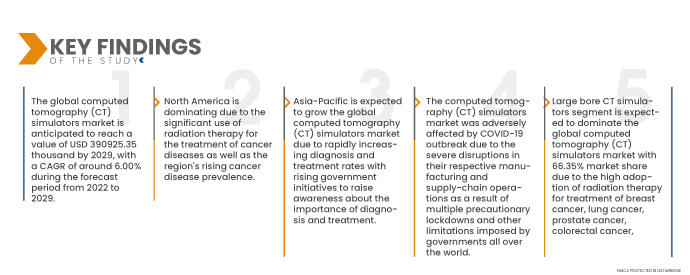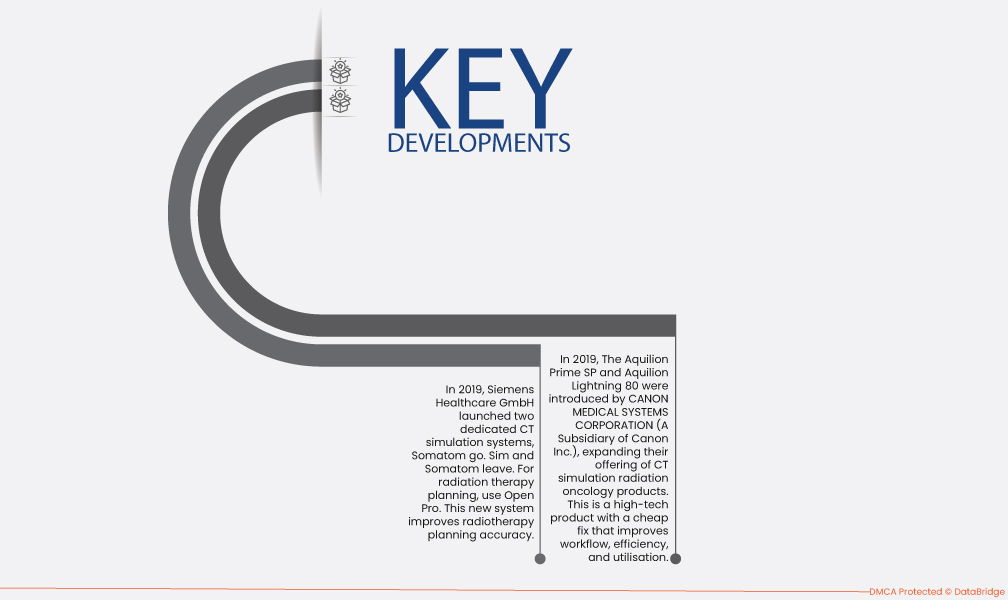Расширение использования внешней лучевой терапии для лечения рака вызывает значительный рост рынка. Одной из наиболее широко используемых форм лучевой терапии для лечения рака является лучевая терапия под визуальным контролем, которая использует визуализацию для повышения точности и правильности доставки лечения. Кроме того, симуляторы КТ часто используются в лучевой терапии под визуальным контролем для сравнения изображений моделирования положения пациента и пучков излучения, чтобы помочь в выравнивании и фокусировке радиационного аппарата для более точного направления дозы облучения на опухоль.
По данным исследования рынка Data Bridge, ожидается, что среднегодовой темп роста рынка симуляторов компьютерной томографии (КТ) составит 6,00% в прогнозируемый период с 2022 по 2029 год, а его объем достигнет 390 925,35 тыс. долларов США к 2029 году по сравнению с 245 271,4 тыс. долларов США в 2021 году.
Ожидается, что рост заболеваемости раком будет способствовать росту рынка
Рак является одной из основных причин смерти в мире. В 2018 году во всем мире было зарегистрировано 18,1 миллиона новых случаев рака и 9,5 миллионов смертей, связанных с раком. Ожидается, что к 2040 году число новых случаев рака возрастет до 29,5 миллионов, а число смертей, связанных с раком, возрастет до 16,4 миллионов. В результате растущая распространенность рака, несомненно, создает огромные рыночные возможности.
Область отчета и сегментация рынка
Отчет Метрика
|
Подробности
|
Прогнозируемый период
|
2022-2029
|
Базовый год
|
2021
|
Исторические годы
|
2020 (Можно настроить на 2014 - 2019)
|
Количественные единицы
|
Доход в млн. долл. США, объемы в единицах, цены в долл. США
|
Охваченные сегменты
|
Тип продукта (симуляторы крупногабаритной компьютерной томографии (КТ) и симуляторы многосрезовой компьютерной томографии (КТ), технология (симуляция 3D КТ и 4D КТ), модальность (автономные и настольные), применение (лучевая терапия под визуальным контролем, трехмерная конформная лучевая терапия, брахитерапия, интервенционные кардиологические процедуры и другие), конечный пользователь (больницы, специализированные центры, амбулаторные хирургические центры и другие), канал сбыта (прямые тендеры и розничные продажи)
|
Страны, охваченные
|
США, Канада и Мексика в Северной Америке, Германия, Франция, Великобритания, Нидерланды, Швейцария, Бельгия, Россия, Италия, Испания, Турция, Остальная Европа в Европе, Китай, Япония, Индия, Южная Корея, Сингапур, Малайзия, Австралия, Таиланд, Индонезия, Филиппины, Остальная часть Азиатско-Тихоокеанского региона (APAC) в Азиатско-Тихоокеанском регионе (APAC), Саудовская Аравия, ОАЭ, Южная Африка, Египет, Израиль, Остальной Ближний Восток и Африка (MEA) как часть Ближнего Востока и Африки (MEA), Бразилия, Аргентина и Остальная часть Южной Америки как часть Южной Америки
|
Охваченные участники рынка
|
Siemens Healthcare GmbH (Германия), General Electric (США), Koninklijke Philips NV (Нидерланды), CANON MEDICAL SYSTEMS CORPORATION (Япония), Hologic, Inc. (США), Shimadzu Corporation (Япония), Fluke (США), Ziehm Imaging GmbH (Германия), DMS (США)
|
Данные, отраженные в отчете
|
Помимо таких рыночных данных, как рыночная стоимость, темпы роста, сегменты рынка, географический охват, участники рынка и рыночный сценарий, рыночный отчет, подготовленный командой Data Bridge Market Research, включает в себя углубленный экспертный анализ, эпидемиологию пациентов, анализ воронки продаж, анализ цен и нормативную базу.
|
Анализ сегмента:
Глобальный рынок симуляторов компьютерной томографии (КТ) подразделяется на шесть основных сегментов, которые различаются по типу продукта, технологии, модальности, применению, конечному пользователю и каналу сбыта.
- По типу продукции мировой рынок симуляторов компьютерной томографии (КТ) сегментируется на симуляторы компьютерной томографии (КТ) большого диаметра и симуляторы многосрезовой компьютерной томографии (КТ).
Ожидается, что сегмент симуляторов компьютерной томографии (КТ) с большим отверстием будет доминировать на мировом рынке симуляторов компьютерной томографии (КТ)
Ожидается, что сегмент симуляторов компьютерной томографии (КТ) с большим отверстием будет доминировать на мировом рынке симуляторов компьютерной томографии (КТ) с долей рынка 66,35% из-за высокого уровня внедрения лучевой терапии для лечения рака молочной железы, рака легких, рака простаты, колоректального рака, лимфомы, рака печени, рака щитовидной железы, рака мозга, рака шейки матки, рака позвоночника и др. Симуляторы компьютерной томографии (КТ) с большим отверстием являются одним из самых передовых и предпочтительных типов устройств моделирования, которые используются для планирования лечения лучевой терапией рака.
- На основе технологий глобальный рынок симуляторов компьютерной томографии (КТ) сегментируется на 3D-моделирование КТ и 4D-моделирование КТ. Ожидается, что сегмент 3D-моделирования КТ будет доминировать на мировом рынке симуляторов компьютерной томографии (КТ) с долей рынка 68,17% из-за растущего спроса на устройства для внешней лучевой терапии, такие как LINAC, для лечения рака молочной железы, рака легких, рака предстательной железы, колоректального рака, лимфомы, рака печени, рака щитовидной железы, рака мозга, рака шейки матки, рака позвоночника и других.
- По принципу модальности мировой рынок симуляторов компьютерной томографии (КТ) сегментируется на автономные и настольные.
Ожидается, что автономный сегмент будет доминировать на мировом рынке симуляторов компьютерной томографии (КТ)
Ожидается, что автономный сегмент будет доминировать на мировом рынке симуляторов компьютерной томографии (КТ) с долей рынка 72,81%, поскольку большинство автономных симуляторов компьютерной томографии (КТ) являются наиболее предпочтительными симуляторами компьютерной томографии (КТ) для моделирования рака во время планирования лучевой терапии онкологами-радиологами.
- На основе применения глобальный рынок симуляторов компьютерной томографии (КТ) сегментируется на лучевую терапию с визуальным контролем, трехмерную конформную лучевую терапию, брахитерапию, процедуры интервенционной кардиологии и другие. Ожидается, что сегмент тестирования лучевой терапии с визуальным контролем будет доминировать на мировом рынке симуляторов компьютерной томографии (КТ) с долей рынка 43,70% из-за высокого уровня внедрения внешней лучевой терапии для лечения рака. Лучевая терапия с визуальным контролем является одним из наиболее предпочтительных типов лучевой терапии, которые используются для лечения рака, поскольку она использует визуализацию во время лучевой терапии для повышения точности и правильности доставки лечения.
- На основе конечного пользователя глобальный рынок симуляторов компьютерной томографии (КТ) сегментируется на больницы, специализированные центры, амбулаторные хирургические центры и другие. Ожидается, что сегмент больниц будет доминировать на мировом рынке симуляторов компьютерной томографии (КТ) с долей рынка 89,91%, поскольку симуляторы компьютерной томографии (КТ) в основном используются для моделирования процесса лучевой терапии, которая выполняется как амбулаторная процедура в основном в больницах, которая обычно занимает менее 60 минут, и больницы являются одной из первых точек контакта и наиболее надежным вариантом для пациентов в разных странах для лечения онкологических заболеваний.
- На основе канала дистрибуции глобальный рынок симуляторов компьютерной томографии (КТ) сегментируется на прямые торги и розничные продажи. Ожидается, что сегмент прямых торгов будет доминировать на мировом рынке симуляторов компьютерной томографии (КТ) с долей рынка 87,20%, поскольку большинство больниц, специализированных центров, амбулаторных хирургических центров и академических и исследовательских организаций предпочитают прямые торги, стремясь получить преимущества от оптовых закупок, скидок и легкой доступности продукции.
Основные игроки
Data Bridge Market Research выделяет следующие компании в качестве основных игроков на рынке симуляторов компьютерной томографии (КТ): Siemens Healthcare GmbH (Германия), General Electric (США), Koninklijke Philips NV (Нидерланды), CANON MEDICAL SYSTEMS CORPORATION (Япония), Hologic, Inc. (США), Shimadzu Corporation (Япония), Fluke (США), Ziehm Imaging GmbH (Германия), DMS (США).
Развитие рынка
- В 2019 году Siemens Healthcare GmbH представила две специализированные системы моделирования КТ Somatom go. Используйте Open Pro при планировании лучевой терапии. Новый метод повышает точность планирования лучевой терапии. Портфель продуктов компании был расширен в результате запуска новых продуктов, и рынок принес достаточно дохода для бизнеса.
- В 2019 году компания CANON MEDICAL SYSTEMS CORPORATION (дочерняя компания Canon Inc.) представила Aquilion Prime SP и Aquilion Lightning 80, расширив свое предложение продуктов для КТ-симуляции радиационной онкологии. Это высокотехнологичный продукт с недорогим исправлением, который улучшает рабочий процесс, эффективность и использование. Запуск новых вещей расширил линейку продуктов компании, и бизнес зарабатывает достаточно денег на рынке.
Региональный анализ
Географически страны, охваченные отчетом о рынке симуляторов компьютерной томографии (КТ), следующие: США, Канада и Мексика в Северной Америке, Германия, Франция, Великобритания, Нидерланды, Швейцария, Бельгия, Россия, Италия, Испания, Турция, Остальная Европа в Европе, Китай, Япония, Индия, Южная Корея, Сингапур, Малайзия, Австралия, Таиланд, Индонезия, Филиппины, Остальная часть Азиатско-Тихоокеанского региона (APAC) в Азиатско-Тихоокеанском регионе (APAC), Саудовская Аравия, ОАЭ, Южная Африка, Египет, Израиль, Остальной Ближний Восток и Африка (MEA) как часть Ближнего Востока и Африки (MEA), Бразилия, Аргентина и Остальная часть Южной Америки как часть Южной Америки.
Согласно анализу Data Bridge Market Research:
Северная Америка будет доминирующим регионом на рынке симуляторов компьютерной томографии (КТ) в прогнозируемый период 2022–2029 гг.
Северная Америка доминирует благодаря значительному использованию лучевой терапии для лечения онкологических заболеваний, а также растущей распространенности онкологических заболеваний в регионе, более широкому использованию КТ-симуляторов для обучения лечению рака молочной железы, легких, предстательной железы, толстой кишки, лимфомы, щитовидной железы, головного мозга, шейки матки и позвоночника.
По оценкам, Азиатско-Тихоокеанский регион станет самым быстрорастущим регионом на рынке симуляторов компьютерной томографии (КТ) в прогнозируемый период 2022–2029 гг.
Ожидается, что в Азиатско-Тихоокеанском регионе будет наблюдаться рост мирового рынка симуляторов компьютерной томографии (КТ) за счет усиления правительственных инициатив по повышению осведомленности о важности диагностики и лечения, а также роста объемов лечения и диагностики.
Анализ воздействия COVID-19
Почти каждая отрасль промышленности испытала спад за последние 18 месяцев. Это можно объяснить серьезными сбоями в их соответствующих производственных операциях и цепочках поставок в результате многочисленных мер предосторожности и других ограничений, введенных правительствами по всему миру. Кроме того, предпочтения потребителей снизились, поскольку люди теперь гораздо больше сосредоточены на исключении несущественных расходов из своих бюджетов, поскольку общая экономическая ситуация большинства людей была негативно затронута этой вспышкой. Вышеупомянутые факторы, вероятно, окажут негативное влияние на траекторию доходов рынка симуляторов компьютерной томографии (КТ) в течение прогнозируемого периода.
Более подробную информацию об отчете о рынке симуляторов компьютерной томографии (КТ) можно найти здесь – https://www.databridgemarketresearch.com/reports/global-ct-simulators-market












